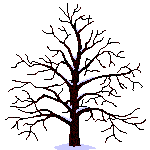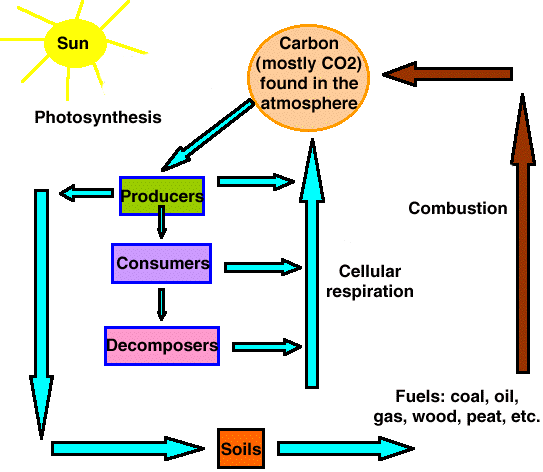Ecology
All Materials © Cmassengale
Ecology is the study of interactions between organisms (biotic part) and their nonliving environment (abiotic factors)
Biotic factors includes plants, animals, fungi, & microorganisms. They may be producers, consumers, or decomposers.
Abiotic factors include climate, soil, temperature, water, air, sunlight, humidity, pH, and atmospheric gases.
Habitat is the place a plant or animal lives, while its niche is its total way of life.
Life is organized into levels:
Organism (any single living thing)
¯
Population (members of the same species living in one place)
¯
Community (all the populations living in an area)
¯
Ecosystem (community living in a similar habitat such as a forest)
¯
Biomes (ecosystems covering wide areas & with similar climates & organisms)
¯
Biosphere ( all the living & nonliving things on earth)
Producers:
| Make their own food through photosynthesis or chemosynthesis | |
| Includes plants, algal protists, & some bacteria |
Consumers:
| Can’t make their own food | |
| May be herbivores (feed only on plants), carnivores (feed only on animals), or omnivores (feed on plants & animals) |
Decomposers:
| Break down dead plants & animals (detritus) | |
| Recycle nutrients | |
| Called detritivores | |
| Include fungi & bacteria |
Sunlight is the ultimate energy for all life on earth, but only producers can get their energy directly from the sun.

Trophic levels are feeding levels of producers & consumers in an ecosystem:
| 1st Trophic Level is producers that use sunlight directly | |
| 2nd Trophic Level includes herbivores that feed directly on plants | |
| Higher Trophic Levels are carnivores feeding on each other |

Food chains & food webs:
| Chains show who eats whom in an ecosystem. | |
| Webs are made up of several food chains. | |
| Always begin with producers absorbing sunlight. | |
| Producers store energy in the chemical bonds of the food they make. | |
| Stored energy is passed to consumers when they eat producers or other consumers. | |
| Some energy is lost at each trophic level as heat when consumers “burn” food during cellular respiration. | |
| Both energy & nutrients must move through an ecosystem. |

Three main elements that must move through an ecosystem:
| Water | |
| Carbon | |
| Nitrogen |
Water or Hydrologic Cycle:
| Cells are 70 – 90% water | |
| Water is needed for metabolic processes | |
| Water is most important for terrestrial organisms because of desiccation (drying out) |
Steps in the water Cycle:
Evaporation Transpiration
(water loss from lakes, rivers, oceans…) (water loss from plant leaves)
¯ ¯
Condensation
(water vapor forms clouds)
¯
Precipitation
(water returns to earth as sleet, rain, snow…)
¯
Surface Runoff
(returns water to bodies of water or to groundwater)
Carbon Cycle:
| Consists of photosynthesis, cellular respiration, & decomposition | |
| Begins with producers taking carbon dioxide from the air during photosynthesis | |
| Carbon dioxide used in cellular respiration | |
| Decomposing plants and animals return Carbon to the soil |
Carbon Cycle Steps:
Plant leaves take carbon dioxide from air
¯
Plants store carbon in carbohydrates or starches
(photosynthesis)
¯
Plants & animals release carbon dioxide back into the air
(cellular respiration)
¯
Decomposers return carbon to environment
(decomposition)
Nitrogen:
| Needed by all organisms | |
| Used to make proteins & nucleic acids (DNA & RNA) | |
| Air made up of 80% nitrogen | |
| Only Cyanobacteria & Rhizobium bacteria can use nitrogen directly from the air (nitrogen fixation) | |
| Bacteria found in the soil & on the roots of legumes (beans, peas …) |
Steps in the Nitrogen Cycle:
Cyanobacteria & Rhizobium take nitrogen from air
(nitrogen fixation)
¯
Convert nitrogen gas into ammonia
¯
Nitrifying bacteria in soil change ammonia into nitrates
¯
Plants can absorb & use nitrates to make proteins
¯
Consumers eat plants & get proteins containing nitrogen
¯
Decomposers break down dead organisms & return nitrogen to air
(called ammonification)
¯
Anaerobic bacteria in soil release nitrogen from nitrates into air
(called denitrification)
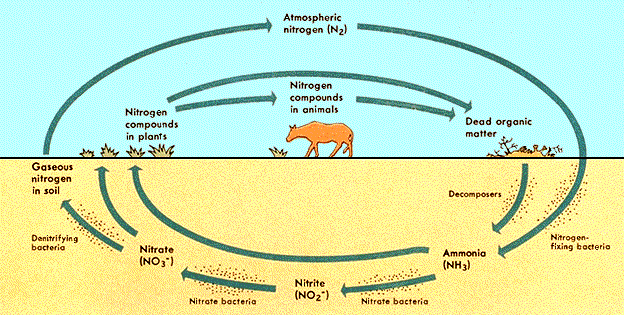
Three main types of ecosystems:
| Terrestrial (land) | |
| Freshwater (rivers, ponds, lakes …) | |
| Marine (oceans & seas) |
Terrestrial ecosystems are divided into 7 biomes with similar climates & organisms
Seven Terrestrial Biomes:
| Tropical Rain Forest (jungle) | |
| Savanna (tropical grasslands) | |
| Deserts | |
| Grasslands | |
| Deciduous Forest | |
| Taiga (coniferous forest) | |
| Tundra |
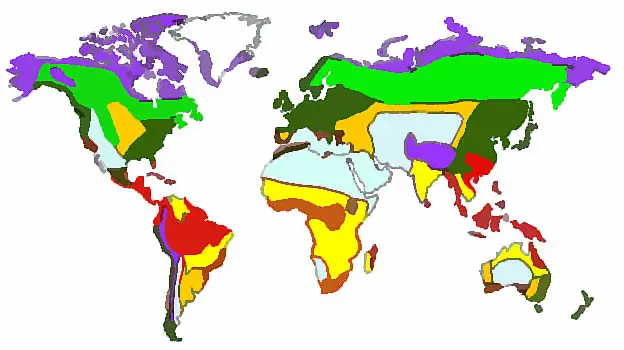
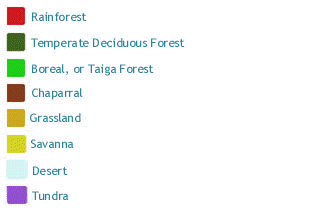
Tundra:
| Cold & dark most of the year | |
| Includes the arctic | |
| Permafrost is the top layer of soil that thaws & in which plants grow | |
| No trees, but sedges & grass, mosses, & lichens | |
| Many migratory animals | |
| Lemmings & ptarmigans are year round residents | |
| Approximately 20 cm annual rainfall |
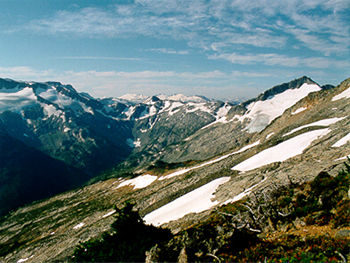
Taiga:
- Coniferous forest
- Extends across northern Eurasia & North America
- Contains conifers or evergreens (spruce, cedar, fir, pine …)
- Needle like leaves withstand weight of snow
- Bear, deer, moose, wolves, mountain lions …
- Sequoia or redwood (largest conifer) grows here
- Bristle cone pine oldest living conifer found here

Temperate Deciduous Forest:
- South of taiga in North America, eastern Asia, & Europe
- High annual rainfall (75-150 cm)
- Moderate temperatures
- Well-defined seasons of about equal length
- Trees loose leaves in winter (deciduous)
- Show stratification (plant layers):
1. Canopy – broad leaf deciduous trees forming uppermost layer
2. Under story – shrubs
3. Forest Floor – herbaceous plants - Songbirds, deer, rabbits, foxes, squirrels, frogs 7 toads, lizards …
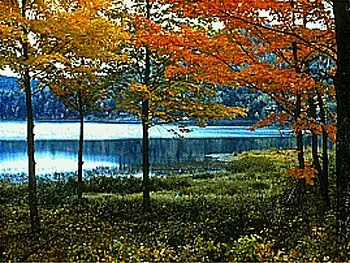
Tropical Rain forest:
- Near equator
- Warm climate (20 -25 degrees C)
- Plentiful rainfall (190 cm/year)
- Contains the greatest diversity of plants & animals
- Insects, monkeys & apes, snakes, tropical birds, leopards…
- Animals & plants brightly colored
- Poor soil for agriculture

Grasslands:
- Mostly grasses with a few trees due to less rainfall
- Moderate climates
- Good for agricultural crops
- Grazing & burrowing animals dominate
- Also called prairies

Savanna:
- Tropical grasslands
- Warm climate & rainy season
- Antelope, zebra, lions, wildebeests, hyenas, elephants…
- Suffer from floods & drought

Deserts:
- Low annual rainfall
- Subject to strong winds
- Days usually hot & nights cold
- Sahara desert is without vegetation
- Succulents such as cacti & other water storing plants
- Most animals nocturnal
- Lizards, snakes, roadrunners, insects, tarantula, hawks, rodents, coyotes…
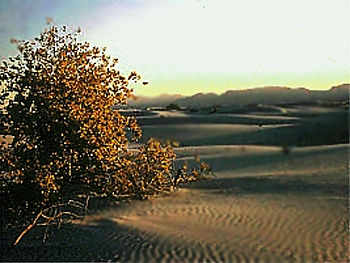
Aquatic Biomes:
- May be freshwater or saltwater
- Wetlands near oceans have brackish water (mixture of fresh & salt waters)
- Part of the part water or hydrologic cycle
- Often polluted by man’s activities
Lakes & Rivers:
- Freshwater
- Oligotrophic lakes are nutrient poor (catfish, carp…)
- Eutrophic lake are nutrient rich (trout, bass…)
- Deep lakes have layers or strata where different plants & animals live
- Phototropic organisms in upper layers for light
- Estuary at mouth of river contains brackish water
Ocean Zones:
- Intertidal zone
1. Along shoreline
2. Wave action
3. Lots of light so many producers
4. Starfish, sand dollars… - Neritic Zone
1. Ocean water above continental shelf
2. Coral reef found here
3. Surrounds continents & receives light in upper layers - Oceanic Zone
1. Beyond continental shelf
2. Deepest area (up to 7 miles)
3. Bottom doesn’t receive light so animals adapted to darkness (many produce their own light, feed on other animals…)
4. Deepest area called abyss
5. Upper area gets light & called the photic zone (lots of seaweed here)
6. Floaters called plankton (microscopic organisms)
7. Swimmers such as fish called nekton
8. Bottom dwellers called benthos

